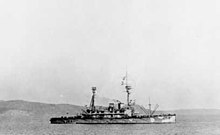Armistice of Moudros
The Moudros armistice , which ended hostilities between the Ottoman Empire and the Entente in the Middle Eastern theater of World War I , was signed on October 30, 1918 by the Turkish Navy Minister Rauf Orbay and the British Admiral Somerset Gough-Calthorpe on board the HMS Agamemnon in the port of Signed Moudros on the Greek island of Limnos .
prehistory
After the Turks had sent the British prisoner-of-war General Townshend to Moudros with the message of their readiness to negotiate an armistice, negotiations began on the morning of October 27th. Admiral Calthorpe began the conference to the exclusion of his French colleague Admiral Amet , who was to attend as the representative of the Commander-in-Chief of the French Mediterranean Fleet, Admiral Gauchet . For the autumn of 1918, the British and the French had a bitter dispute over command of the Allied fleet in the Aegean Sea . Britain's solo effort was also influenced by France's similar behavior on the ceasefire agreement with Bulgaria . Great Britain was obviously trying to secure a dominant position in the Middle East.
agreement
The Moudros armistice ended the struggle between the Ottoman Empire on the one hand and the Allies ( Great Britain , France , Italy and Japan ) represented by Great Britain on the other. The agreement consists of 25 clauses. It is signed by Admiral Arthur Calthorpe, Minister of the Navy Rauf Orbay, Secretary of State Rechad Hikmet, and Lieutenant Colonel Saadullah. According to point 25 of the agreement, the hostilities were to end at noon on Thursday, October 31, 1918.
With the signing of the armistice, the Ottomans gave up their remaining positions outside Anatolia and gave the Allies the right to take over fortresses, the Dardanelles , the Bosporus , Istanbul (§1), all ports, railway connections (§15), radio communications (§12 ) and to control the entire fleet on the Anatolian coastline, to occupy the “ six Armenian provinces ” in Eastern Anatolia “in the event of unrest” (§24) and to conquer “every strategic point” in the event of a threat to Allied security. The Ottoman army was to be disarmed and Turkish ports, railways and other strategic points were made available for use by the Allies.
So the agreement was a purely British-Turkish affair. However, most of the clauses were worked out jointly on October 7, 1918 at an Allied conference. However, there were two major clause changes in the final document:
- The original draft called for the immediate withdrawal of Turkish troops from Cilicia , the final version gave Turkey the right to stay if it was necessary to maintain law and order; Cilicia was an area that the French saw as under their influence after the war, with this change of clause France's interests in the Middle East were attacked,
- The original draft gave Allied forces the right to besiege any strategic point, the final version added "in the event of a situation threatening the security of the Allies"; a formulation that heeded Turkish domestic affairs but left the door open for action, particularly with regard to actions to prevent the spread of Bolshevism from Russia.
consequences
The Ottomans had to give up their entire empire with the exception of Anatolia and a small European part around Istanbul and thus also lost de jure control of their possessions on the Arabian Peninsula and in the Middle East ( Hejaz , Yemen , Syria , Palestine , Mesopotamia ) in fact had already been snatched from them during the course of the war. In addition to the Allied occupation of key positions around the Sea of Marmara , Batumi and the heights of the Taurus Mountains were also occupied and authorization was granted to occupy six provinces of Armenian populations in northeastern Anatolia in the event of unrest. By controlling the Bosporus , the Allies also had the capital Constantinople under their influence, which forced the Young Turks , who had built up a revolutionary government there, to flee. In the Caucasus , Turkey had to withdraw behind the borders that were in place before the war.
The Treaty of Sèvres (1920), which included clauses on the possible establishment of an independent Kurdistan and an enlarged Armenia , would have further reduced the size of the areas controlled by Turkey , but the treaty did not go into effect as the Sultan dissolved parliament and the Turkish Liberation War broke out under the leadership of Mustafa Kemal Ataturk . The fighting was directed against Greece, Armenia and the French occupying power in Anatolia, which were supported by Great Britain and Italy. At its end there was the Treaty of Lausanne with the newly formed Republic of Turkey, which turned out to be much more advantageous for the Turkish side.
literature
- Laura M. Adkisson: Great Britain and the Kemalist Movement for Turkish Independence, 1919-1923 . University Microfilms International, Ann Arbor MI 1958, (Univ. Of Texas, Phil. D. Thesis).
- Paul C. Helmreich: From Paris to Sèvres. The Partition of the Ottoman Empire at the Peace Conference of 1919-1920 . Ohio State University Press, Columbus OH 1974, ISBN 0-8142-0170-9 , pp. 3–5, the entire text of the agreement is on pp. 341f.
- Patrick Balfour Kinross: Ataturk. A biography of Mustafa Kemal, father of modern Turkey . Morrow, New York NY 1965.
- Sir Frederick B. Maurice: The Armistices of 1918 . Oxford University Press, London et al. 1943.
- Feroz Ahmad: The young Turks: struggle for the Ottoman Empire, 1914-1918, Istanbul Bilgi University Press, Istanbul 2019, ISBN 978-605-399-530-2 .
- Jeremy Salt: The last Ottoman wars: the human cost, 1877-1923, The University of Utah Press, Salt Lake City 2019, ISBN 978-1-60781-704-8 .
